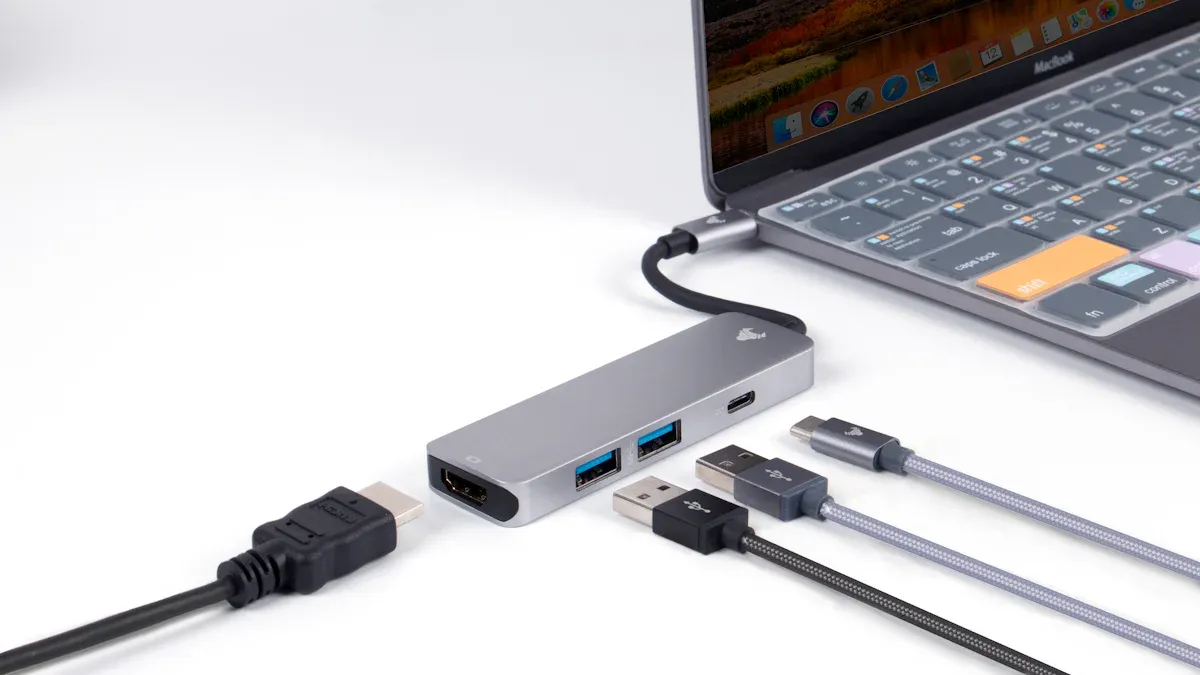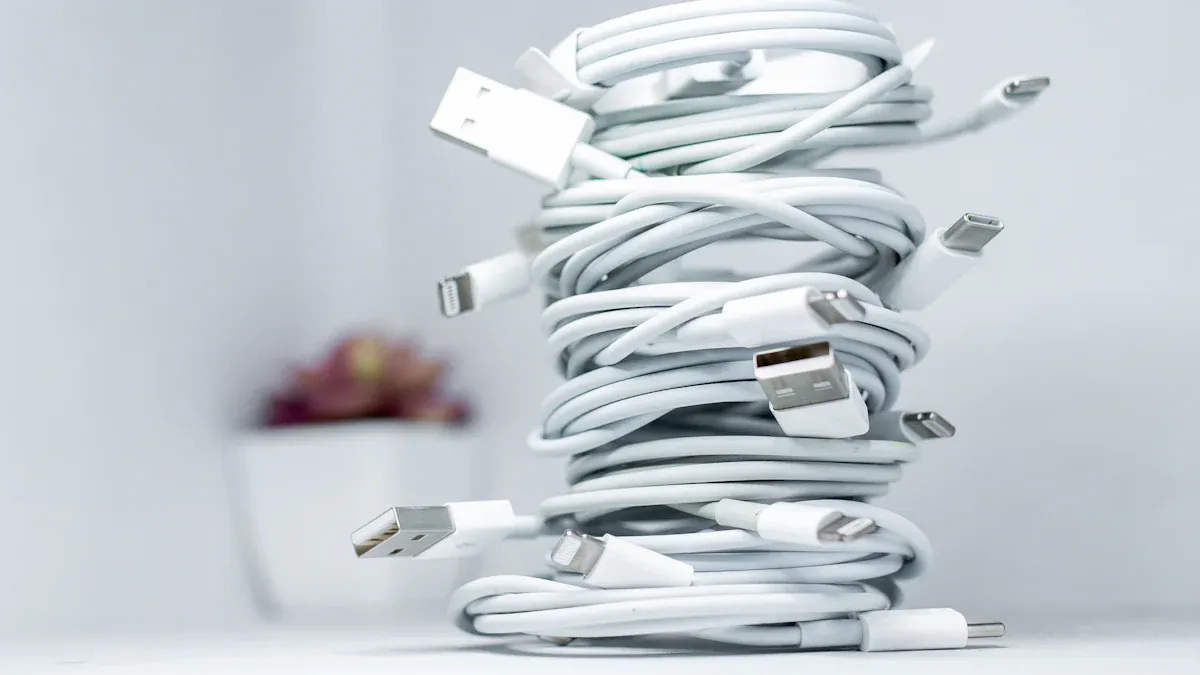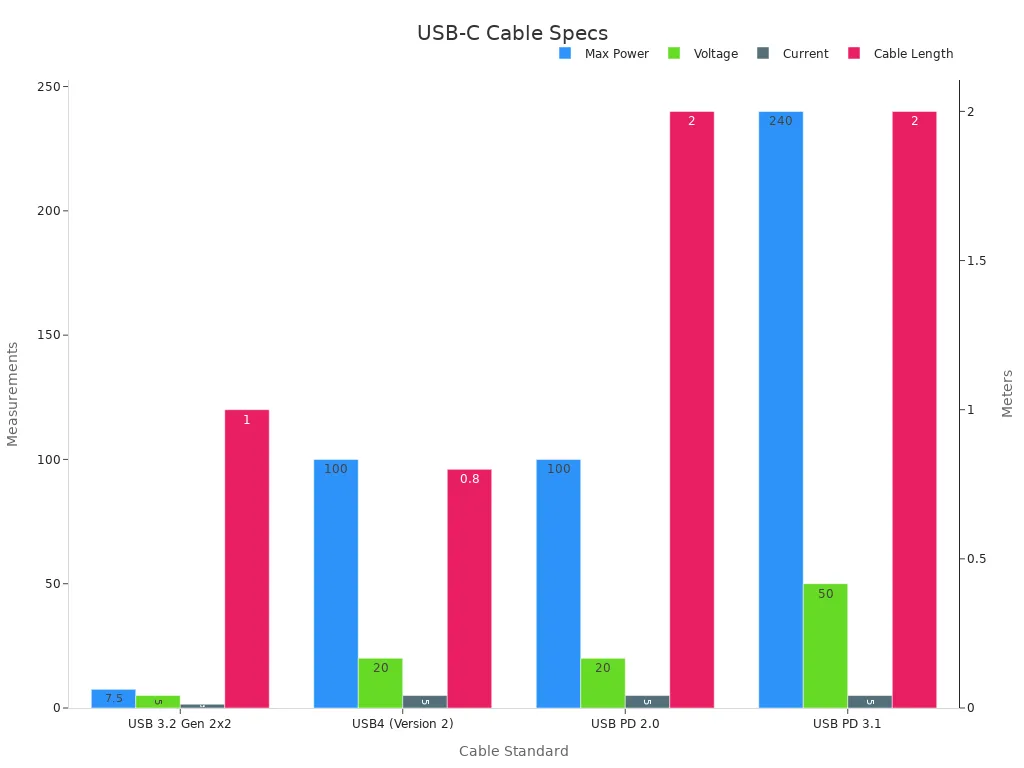Choosing the right USB-C iPhone cable is more than just picking one off the shelf. You want something reliable that charges fast and lasts a long time. Consumers today lean toward cables with better charging speeds and durable designs like braided ones. Longer cables are also popular for their convenience. If you’re eco-conscious, look for options made from recycled materials. Branded cables are a safe bet since most people trust them for quality and performance.
Ensuring Compatibility with Your USB-C iPhone Cable
When buying a USB-C iPhone cable, ensuring compatibility is crucial. A cable that doesn’t work with your device can lead to frustration, slower charging, or even damage. Let’s break down how you can check compatibility and avoid these issues.
Checking iPhone Model Compatibility
Not all iPhones use the same charging port. If you own an iPhone 15, you’ll need a USB-C cable since Apple switched from Lightning to USB-C ports for this model. This change allows for faster charging and data transfer. However, if you have an older model like the iPhone 14, you’ll still need a Lightning cable. Always double-check your iPhone model before purchasing a cable.
Here are some quick tips to ensure your cable works with your iPhone:
– Look for certified USB-C cables for iPhone 15 models. These cables ensure optimal performance and safety.
– If you’re unsure about your iPhone model, check the settings under “About” to confirm.
– Avoid generic or non-certified cables, as they may not support fast charging or data transfer.
Verifying Compatibility with Other Devices
A USB-C cable isn’t just for your iPhone. You might also use it to charge other devices like AirPods, an Apple Watch, or even non-Apple gadgets. However, not all USB-C cables are created equal. Some may not work well with devices that require higher power or specific protocols.
For example, while most USB-C cables can handle basic charging, problems can arise with devices needing more than 3A or 60W. Certified cables, tested by organizations like the USB Implementers Forum (USB-IF), meet strict standards for charging power and data transfer. This ensures they work across a wide range of devices. Keep this in mind if you plan to use your cable for multiple gadgets.
Understanding USB-C to Lightning Standards
If you’re transitioning from an older iPhone to the iPhone 15, you might wonder about USB-C to Lightning cables. These cables are designed to connect devices with a Lightning port to those with a USB-C port. They’re handy for syncing data between older iPhones and newer devices.
However, compatibility issues can arise if the cable doesn’t meet Apple’s standards. Look for cables with MFi (Made for iPhone) certification. This ensures the cable is designed to work seamlessly with Apple products. Without this certification, you risk slower data transfer speeds or even damage to your device.
Pro Tip: If you’re buying a USB-C to Lightning cable, check the packaging for details about data transfer speeds. Some cables support USB 3.0 or higher, which is ideal for transferring large files quickly.
By understanding these compatibility factors, you can choose a USB-C iPhone cable that meets your needs and works flawlessly with your devices.
Prioritizing Durability in a USB-C iPhone Cable
When it comes to USB-C iPhone cables, durability is key. A sturdy cable can save you from the hassle of frequent replacements and ensure reliable performance over time. Let’s explore what makes a cable durable and how you can choose one that lasts.
Choosing the Right Materials (Nylon Braided vs. Plastic)
The material of your cable plays a huge role in its durability. Nylon braided cables are a popular choice because they’re tougher than standard plastic ones. The tightly woven fabric acts as a shield, protecting the cable from fraying, kinking, or breaking. These cables also handle bending and tangling better, making them perfect for everyday use. On the other hand, plastic cables are lighter and more affordable but tend to wear out faster, especially with frequent use. If you want a cable that can handle wear and tear, a nylon braided option is your best bet.
Benefits of Reinforced Connectors
The connectors on your cable are often the first to fail. That’s why reinforced connectors are a game-changer. They’re designed to withstand repeated plugging and unplugging without breaking. Look for cables with metal or rubber reinforcements around the connector ends. These features add extra strength and prevent damage, even if you’re rough with your cable.
Importance of Tangle-Free and Flexible Designs
Nobody likes dealing with tangled cables. A tangle-free design not only saves time but also reduces stress on the cable, extending its lifespan. Flexible cables are easier to use and store, especially if you’re always on the go. Whether you’re charging your phone at home or transferring files with high-quality usb data transfer cables, a flexible and tangle-free design makes life easier.
Pro Tip: Always check the packaging for durability features like braided materials, reinforced connectors, and tangle-free designs. These small details can make a big difference in how long your cable lasts.
Evaluating Charging Speed and Data Transfer
When choosing a USB-C cable for your iPhone 15, charging speed and data transfer performance are critical. A high-quality cable ensures a smooth charging and syncing experience while saving you time. Let’s dive into what you should look for.
Identifying Fast Charging Support (PD-Compatible Cables)
Fast charging is a game-changer, especially when you’re in a hurry. To take advantage of this feature, you need a cable that supports Power Delivery (PD). PD-compatible cables allow your iPhone 15 to charge up to 50% in about 30 minutes. Look for cables labeled as “PD-compatible” or “fast charging” to ensure they meet this standard.
Tip: Pair your PD-compatible cable with a charger that supports at least 20W output for the best results.
Understanding Data Transfer Speeds (USB 3.0 or Higher)
Data transfer speed is another important factor, especially if you frequently move large files like videos or photos. USB-C cables come with different data transfer rates, and not all are created equal. For example, USB 3.0 cables can transfer data at speeds of up to 5Gbps, while USB 3.2 Gen 2×2 can go up to 20Gbps.
Here’s a quick comparison of USB standards:
| Standard | Power (Max) | Voltage | Current | Max Cable Length (Passive) |
|---|---|---|---|---|
| USB 3.2 Gen 2×2 | 7.5W | 5V | 1.5A | 1m |
| USB4 (Version 2) | 100W | 20V | 5A | 0.8m |
| USB PD 2.0 | 100W | 20V | 5A | 2m |
| USB PD 3.1 | 240W | 50V | 5A | 2m |
For the fastest data transfer, choose a cable that supports USB 3.0 or higher. This ensures you get the most out of your iPhone 15’s capabilities.
Checking Wattage and Amperage Ratings
The wattage and amperage ratings of a cable determine how efficiently it can charge your device. For example, a cable with a 5A current rating and 20V voltage can deliver up to 100W of power. This is ideal for fast charging and ensures your cable can handle the power demands of your iPhone 15.
Always check the packaging or product description for these ratings. A higher wattage and amperage rating means better performance and faster charging.
Pro Tip: Avoid using cables with low ratings, as they may overheat or fail to charge your device properly.
By focusing on these factors, you can pick a USB-C cable that delivers excellent speed and performance for both charging and data transfer.
Importance of Safety Certifications for USB-C iPhone Cables
When buying a USB-C iPhone cable, safety certifications should be at the top of your checklist. These certifications ensure your cable is reliable, safe, and compatible with your devices. Let’s explore why they matter and how they protect your iPhone and other gadgets.
Why MFi Certification Matters
MFi (Made for iPhone) certification is Apple’s way of ensuring third-party accessories meet their safety and performance standards. When you see the MFi logo on a charging cable, you can trust that it’s been tested to work seamlessly with your iPhone or other Apple devices.
Here’s why MFi certification is so important:
– It ensures the cable meets Apple’s safety standards, reducing the risk of overheating or damaging your device.
– It prevents issues like inconsistent charging or data transfer interruptions.
– It guarantees compatibility with your iPhone 15, iPhone 14, and other Apple products.
Without MFi certification, you’re taking a gamble. Non-certified cables might look the same, but they often lack the quality control needed to protect your devices.
Tip: Always check for the MFi logo when buying a USB-C iPhone cable. It’s a small detail that can save you from big headaches later.
Risks of Non-Certified or Counterfeit Cables
Using non-certified or counterfeit cables might seem like a way to save money, but it can lead to serious problems. These cables often cut corners in design and materials, which can compromise safety and performance.
Here are some of the risks you face with non-certified cables:
– Performance issues: They may not deliver consistent power, leading to slower charging or unstable data transfers.
– Fire hazards: Poor-quality materials can overheat, increasing the risk of fires.
– Electrical safety hazards: Faulty wiring can damage your device or even cause electric shocks.
Non-certified cables might work fine at first, but their lack of reliability can cause long-term damage to your devices. It’s better to invest in a certified charging cable that ensures safety and performance.
Additional Safety Standards to Consider
While MFi certification is essential for Apple devices, other safety standards can also help you choose a reliable data cable. Look for cables that meet these additional certifications:
– USB-IF certification: This ensures the cable complies with USB standards for charging and data transfer.
– RoHS compliance: This guarantees the cable is free from hazardous materials, making it safer for you and the environment.
– CE marking: This indicates the cable meets European safety, health, and environmental protection standards.
These certifications add an extra layer of assurance that your cable is safe, durable, and high-performing.
Pro Tip: Check the product description or packaging for these certifications. A little research now can save you from costly repairs later.
By prioritizing safety certifications, you can protect your iPhone and other devices while enjoying fast and reliable charging. Don’t settle for less when it comes to your tech accessories.
Balancing Cost and Quality for Value
Finding the perfect balance between cost and quality can feel tricky when shopping for a USB-C iPhone cable. You want something reliable without overspending. Let’s explore how you can get the best value for your money.
Tips for Balancing Price and Quality
Not all expensive cables are worth the price, and not all cheap ones are bad. To strike the right balance, focus on features that matter most to you. Look for MFi-certified cables, as they guarantee safety and compatibility with your iPhone. Avoid non-certified options, even if they’re cheaper, because they can damage your device.
Some brands, like the iWALK Leopard GaN series, offer affordable yet durable cables. These come with a lifetime warranty, showing the brand’s confidence in their product. A warranty like this adds value, as you won’t need to replace the cable often.
Pro Tip: Compare prices online and read reviews to see if a cable delivers on its promises. A little research can save you money and frustration.
Recognizing Reliable Brands
Sticking to trusted brands is one of the easiest ways to ensure quality. Brands like Anker, Belkin, and Apple have a solid reputation for producing high-quality data cables. They prioritize safety, durability, and performance.
Reliable brands often include certifications like MFi, UL, or CE on their packaging. These certifications show that the cable meets strict safety and performance standards. When in doubt, choose a brand with a proven track record.
Avoiding Counterfeit USB-C iPhone Cables
Counterfeit cables might look like the real deal, but they’re often poorly made. They can overheat, fail to charge properly, or even damage your iPhone. To avoid these, always buy from authorized retailers or the brand’s official website.
Here’s how to spot a fake cable:
– Missing certifications like MFi or USB-IF.
– Unusually low prices that seem too good to be true.
– Poor packaging or misspelled brand names.
Reminder: A counterfeit cable might save you a few bucks upfront, but it could cost you more in the long run if it damages your device.
By focusing on quality, trusted brands, and certifications, you can find a USB-C iPhone cable that offers great value without breaking the bank.
Choosing the right USB-C iPhone cable doesn’t have to be tricky. Focus on compatibility, durability, charging speed, safety certifications, and value. Certified cables, like name-brand options, perform best. Avoid counterfeit ones—they’re unreliable. Use this checklist:
- ✅ MFi-certified
- ✅ Durable materials
- ✅ Fast charging support
| Charger Type | Rating (Energy Bolts) | Notes |
|---|---|---|
| Name-brand chargers | 4-5 | Generally perform well |
| Counterfeit iPhone charger | 1 | Lowest quality observed |
FAQ
What’s the difference between a USB-C and Lightning cable?
USB-C cables are faster for charging and data transfer. If you own an iPhone 15, you’ll need USB-C instead of Lightning.
Can I use any USB-C cable with my iPhone?
Not all USB-C cables work well. Look for MFi-certified options to ensure compatibility, safety, and optimal performance with your iPhone.
How do I know if a cable supports fast charging?
Check the label for “PD-compatible” or “fast charging.” Pair it with a 20W charger to enjoy quick charging speeds.




